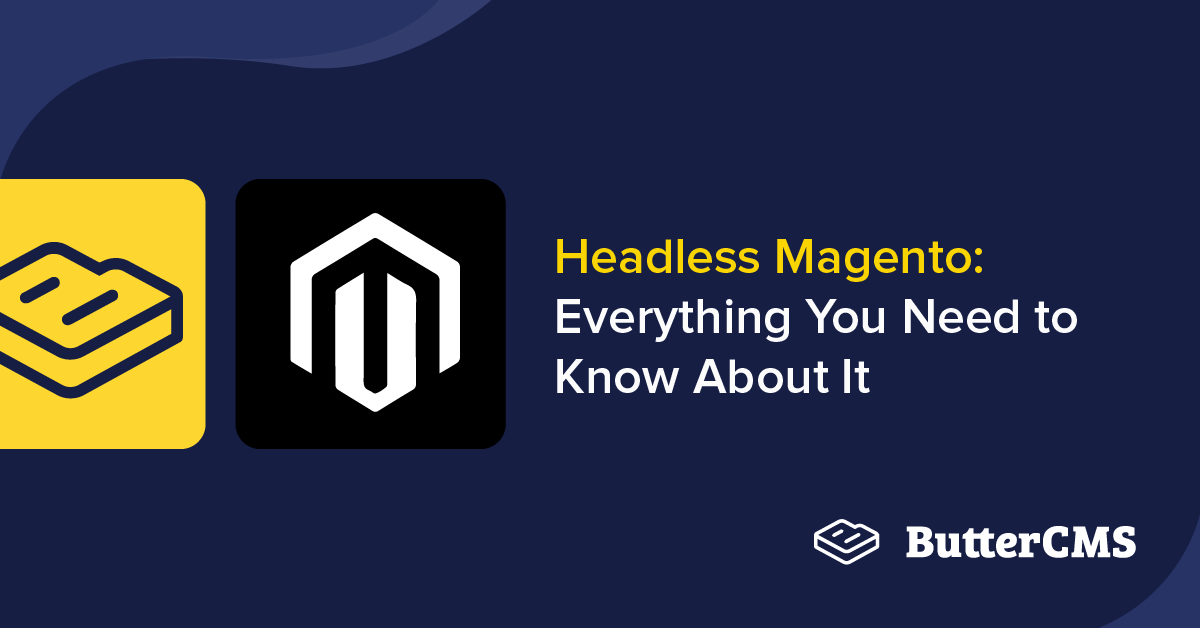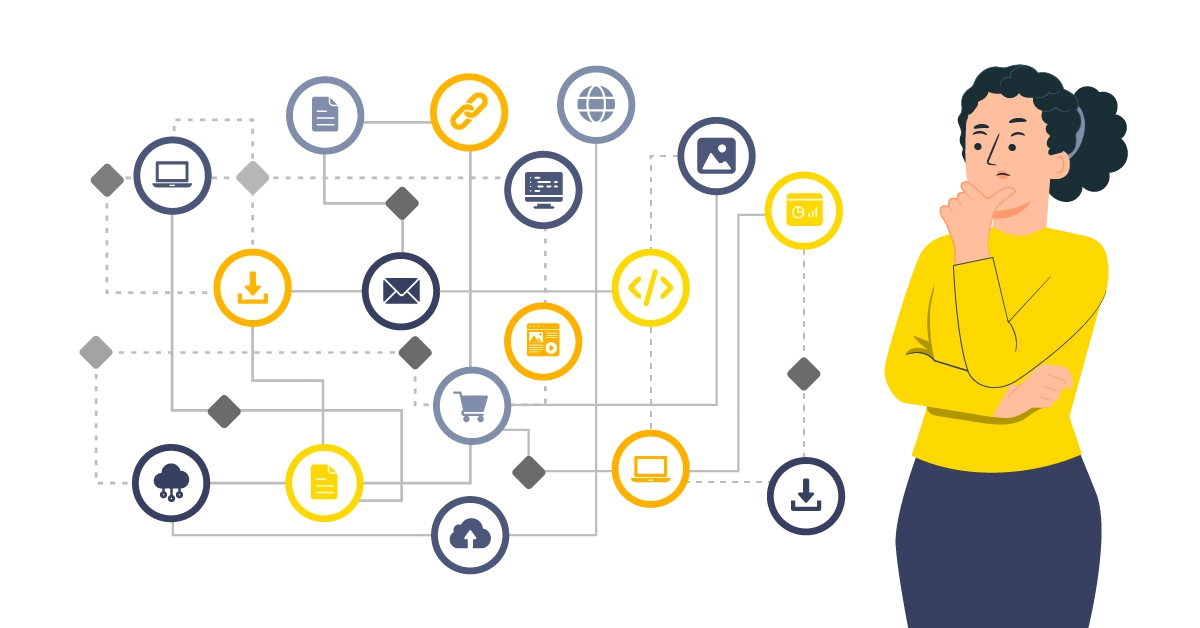
GSD
Headless Magento: Everything You Need to Know About It
Posted by Maab Saleem on October 18, 2023
The headless paradigm is gaining a lot of traction in the e-commerce world – and for good reason. It gives modern businesses the flexibility, customizability, performance, and scalability they need to compete and grow in today’s fast-paced market.
Many traditional e-commerce platforms have started offering headless options, including Magento (now Adobe Commerce). But what is headless Magento …really? How do you set it up? What are its benefits? In the following article, we will answer all these questions, and more.
Table of contents
What is headless Magento?
Magento (now Adobe Commerce) is a popular, open-source e-commerce platform used to build and manage online stores. It offers a range of useful features, including inventory management, customer engagement, fast searching, and AI-driven analytics.
Headless Magento is an approach that decouples the frontend of a Magento store from its backend. The decoupled layers communicate via REST or GraphQL APIs. Since APIs are interoperable, a headless Magento/Adobe backend can connect with frontends written in any language.
This decoupling allows merchants to build personalized storefronts for different channels, and then integrate them all with the same backend. All the commerce-related functions, like payment processing, orders, and product management are still handled by Magento/Adobe Commerce.
How to set up headless Magento?
There are two ways you can go about implementing headless Magento:
Build your own frontend
The first approach is to integrate your existing Magento backend with a frontend built from scratch. You’ll develop a customized storefront, using your preferred frontend technology. Then, you will connect it to the headless Magento/Adobe backend, using APIs. You can even plug in a headless CMS for consolidated content delivery to all your digital touchpoints.
This method offers you the flexibility to design a frontend that truly embodies your brand identity. However, bear in mind that you will need in-house developers to develop and maintain the frontend code. If you don’t have any developers, you can consider outsourcing to an agency, or using a frontend-as-a-service (FEaaS) platform.
Leverage PWA Studio to build a progressive web app
The second method involves building a progressive web app (PWA) for your store. PWAs are web applications that behave and perform just like mobile applications. They load fast, and can even work offline. They offer a consistent experience across different devices, including tablets and desktops.
PWA Studio is a tool suite offered by Adobe that you can use to build a PAW frontend for your headless Magento backend. To work with PWA studio, you will need developers with React.js experience. You can also add a headless CMS to manage the content for your PWA more efficiently.
Benefits of headless Magento for businesses
Headless Magento offers numerous benefits for businesses such as:
Enhanced customization & flexibility
Traditional Magento limits your ability to personalize the storefront. It does offer a page builder with drag-and-drop capabilities, but you can’t use that to customize all areas of the presentation layer. To perform a complete design revamp, you will probably need to develop a custom theme. Developing a custom theme is a difficult process, which requires extensive knowledge of Magento’s internal workings.
A more efficient way to go about building a fully-customized storefront is to go headless. By doing so, you can use your favorite frontend technology to build an immersive and engaging shopping experience for your customers.
Superior omnichannel experiences
A traditional Magento backend can’t support more than one frontend. To serve content to additional touchpoints, you will need to build a new content delivery infrastructure from scratch every time. Conversely, headless Magento gives you the ultimate freedom to add as many frontends as needed. No need to rebuild anything. All you have to do to add a new touchpoint, is design the frontend and integrate it with the existing headless backend.
Faster site speeds
In a traditional Magento setup, the intensive processing of the backend layer can impact the performance and speed of the storefront. The reason: The storefront and backend are modules of the same application, utilizing the same resources. If the application is busy processing multiple payments or orders, the page load time can be impacted.
On the other hand, the performance and speed of a decoupled frontend is not (directly) dependent on the headless backend. The reason: Both run independently, utilizing their own resources. Even if the backend is performing a time-consuming task, the frontend will still run smoothly.
Greater localization and personalization
Traditional Magento does offer some built-in features for localization. Third-party packages for localization and user experience management are also available. However, the overall flexibility is limited. For instance, there’s no easy way to codify custom localization logic.
Contrarily, with headless, having full control over the frontend gives you the ability to personalize content according to user preferences. Using the power of APIs, you can integrate with external services, like a headless CMS, to fetch and serve dynamic, personalized content on the frontend.
Increased scalability
Traditional Magento is a monolithic application which tightly couples the frontend and backend together. This makes it hard to add new functionalities or modify existing features, without risking system instability or performance issues. As your business grows, and the operational complexity increases, it can also become a major roadblock to scaling.
On the other hand, the decoupled frontend and backend of a headless architecture can be scaled independently. The decoupling allows you to change specific parts of the application, without affecting others.
Improved SEO
Headless Magento offers more avenues for SEO than its traditional counterpart. While both solutions allow you to tweak SEO attributes, like rich snippets and URL parameters, only headless offers API-driven, faster-loading sites and channel-based optimization. A responsive, headless-powered store is loved equally by your customers and search engines.
Issues & drawbacks of Headless Magento
Headless promises a lot of great things for merchants. But there are a few potential drawbacks that you must also consider.
Increased complexity
Unlimited flexibility doesn’t come without some complexity. You’ll have to manage the frontend codebase, and fix any detected vulnerabilities or bugs. With a traditional setup, these things are managed by the Magento/Adobe team.
Needs developer involvement
You’ll need ongoing developer support for developing and maintaining the frontend source code. If you don’t have any frontend developers, either find some, or reconsider your decision to go headless.
Costs
Going headless will also increase your total cost of ownership (TCO). Consider the costs related to development, testing, deployment, and maintenance before making the transition.
Examples of headless Magento
Many businesses have solved real-life challenges by going headless. Let’s look at a few examples:
How LoveCrafts went headless to deliver a seamless, omnichannel experience
The LoveCrafts team wanted to transition from traditional Magento to a more adaptive, API-driven platform. Their goal was to decouple the frontend from the backend, and implement an omnichannel strategy.
They decided to go with a cloud-based, headless commerce platform, and a decoupled frontend powered by Vue.js. They also integrated with other third-party applications using APIs. The new architecture enabled them to speed up their website, be more agile, and deliver a truly-omnichannel experience.
How going headless enabled Kaporal to enhance overall performance
As Magento 1 approached end-of-life, Kaporal knew they had to migrate soon. They were interested in an architectural overhaul that would allow them to build a customized frontend, enhance performance, and increase online engagement.
They chose to go headless with Magento 2 to build an extensible, modular infrastructure. The shift allowed them to catalyze growth, build a fully-customizable frontend, optimize SEO, and improve mobile performance.
How Rubik’s leveraged headless Magento to decrease bounce rate and increase revenue
Before going headless, Rubik’s had been using an open-source, traditional e-commerce platform. They wanted to migrate to a scalable, flexible solution that would decrease their bounce rate, increase conversion, and empower their global expansion.
After evaluating multiple options, they went with headless Magento/Adobe Commerce. The switch allowed them to decrease their bounce rate by 20%, and their page-load times to less than a second. They also noticed a 150% increase in their UK revenue, within 6 months.
Headless Magento FAQs
What programming language does Magento use?
Magento uses PHP as its core programming language, and XML to define and store configurations. If you are looking to develop a third-party plugin for Magento, then you will primarily use PHP.
However, many Magento components rely on other programming languages and frameworks: e.g. Magento uses the MySQL database, which is queried using SQL. If you are doing any frontend development, e.g. for Magento themes, you will mainly use CSS, HTML, and JavaScript.
Does Magento require coding?
That depends on whether you are using traditional or headless Magento. Traditional Magento typically doesn’t require coding. However, if you want to extend Magento functionality by building a custom plugin, or want to redesign using a custom theme, you will have to write code in PHP, CSS, HTML, or JavaScript.
If you are using headless Magento, you will require custom coding for the decoupled frontend. You will also need ongoing maintenance of the code to add new features, and fix any vulnerabilities or bugs that pop up. Some fronted technologies you could use are: Next.js, Vue.js, Angular, and React.
Is Shopify better than Magento?
Shopify and Magento are both reliable, open-source e-commerce platforms used by many online stores. Both offer monolithic and headless options. However, there are a few differences between the two that may make you choose one over the other.
Shopify is easier to use than Magento, as it comes with a drag-and-drop website builder. To tweak Magento design, you will probably need to write some code. Shopify also offers a bigger collection of themes.
In terms of features, each platform offers something that the other doesn’t. e.g. Shopify offers built-in support for multichannel selling, whereas Magento doesn’t. Magento is open-source, making it extensible by default, whereas Shopify Plus is closed-source.
Magento doesn’t charge any transaction fee, whereas Shopify charges a per-transaction fee (unless you use Shopify Payments). Shopify comes with reliable hosting and unlimited bandwidth, whereas you will need to buy your own hosting with Magento.
All in all, it won’t be fair to label either platform as the outright winner. You can choose either one depending on your business needs, in terms of flexibility, features, and costs.
Closing thoughts
Headless Magento solves several problems and shortcomings of traditional Magento. It offers merchants a way to go beyond websites, and excel in the world of mobile commerce. Better scalability, performance, SEO, and agility make it an ideal choice for modern, growing businesses.
ButterCMS is the #1 rated Headless CMS
Related articles
Don’t miss a single post
Get our latest articles, stay updated!

















Maab is an experienced software engineer who specializes in explaining technical topics to a wider audience.